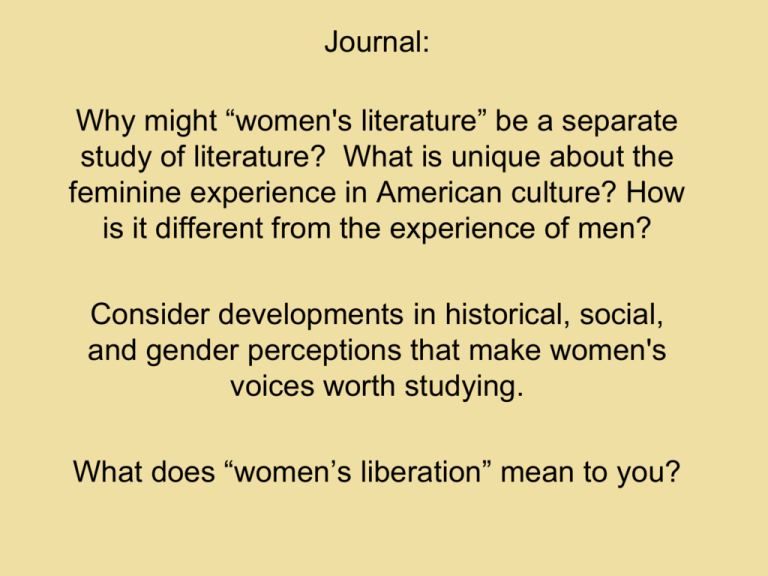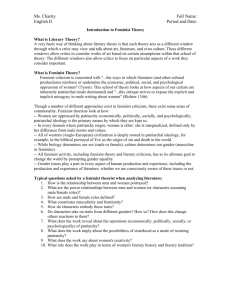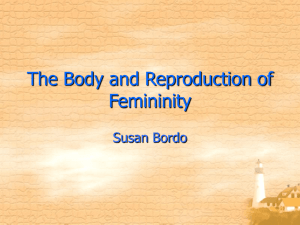18teens was a time of great freedom for women * freedom in speech
advertisement

Journal: Why might “women's literature” be a separate study of literature? What is unique about the feminine experience in American culture? How is it different from the experience of men? Consider developments in historical, social, and gender perceptions that make women's voices worth studying. What does “women’s liberation” mean to you? Charlotte Perkins Gilman -born in 1860 -largely self-educated -attended a design school from age 18-20 -illustrated greeting cards -married in 1884, and gave birth to a daughter in 1885 -later divorced and remarried in 1900 -published 186 short stories, including The Yellow Wallpaper, which appeared in 1892 -wrote throughout her life on women’s issues, advocated women’s right to vote, argued against Darwin’s writings and other scientific theories that described the female mind as functioning differently from the male mind “Female Hysteria” the diagnosis for 25% of women during the 1800s when they had an ailment with no explainable cause. It had 75 possible symptoms and was found mostly in middle class white women Cures: -“rest” cure -“cold water” treatment (pictured) -Marriage and childbirth -tonics and potions Greek word for uterus= hystera Symptoms of a Victorian “hysterical episode” • • • • • • • Fatigue Sleeplessness Irritability Loss of appetite Loss of energy Anxiety Extremely emotional (cries a lot) Why would someone be depressed, wearing an outfit like this? Silas Weir Mitchell was a prominent nerve specialist who promoted the “rest cure” to treat hysteria: - six to eight weeks of bed rest. - patient is forbidden to sit sew, write, draw, read, or do other “work.” - a great deal of bland food - isolation (no visitors) - no excitement Dr. Mitchell prescribed Charlotte his “rest cure” when she turned to him concerning her severe bouts of depression following the birth of her daughter. Charlotte tried to follow the doctor’s directions for several months, but her depression worsened, to the point of developing suicidal tendencies. Her depression lifted when she eventually divorced her husband and took her daughter to live elsewhere. Victorian Era Women and The “Feminine Ideal” Families experienced a major change during this time period. Pre-Industrial Revolution After Industrial Revolution most work done in home by men and women-people made what they needed at home (food, clothing, etc.) work travels outside the home-new industries and companies where men could work as lawyers, clerks, factory managers, physicians, etc. Educational opportunities for women become more widespread Advanced education (college) not widely available to women How does the Industrial Revolution affect women’s place in society? • More women in the workforce-women were earning income, but expected to turn wages over to parents/husbands • Backlash against women working-seen as “unfeminine” (This applies mostly to the world of middle- and upper-class white women.) • “Feminine Ideal” emerges Feminine Ideal • • • • Piety Purity Submissiveness Domesticity The "true" woman was that female at home, "the Valiant Woman of the Bible, in whom the heart of her husband rejoiced and whose price was above rubies" (Welter, 41). Advice to young women: "sit not with another in a place that is too narrow; read not out of the same book; let not your eagerness to see anything induce you to place your head close to another person's." ~Mrs. Eliza Farrar, The Young Woman's Friend "There is more to be learned about pouring out tea and coffee than most young ladies are willing to believe." ~Godey's Ladies Book • Feminist Criticism • There are a number of different models that can be applied when reading a novel, poem, or other literary work. In fact, these different models are used by professional critics in order to determine, or pull from a work, the meaning. One very common model or theory is the Feminist one, a term that is not so foreign in today's day and age as it was when Mary Shelley wrote her classic "Frankenstein" which has now been examined through a Feminist perspective numerous times. Feminist criticism is concerned with "...the ways in which literature (and other cultural productions) reinforce or undermine the economic, political, social, and psychological oppression of women". This school of theory looks at how aspects of our culture are inherently patriarchal (male dominated). • Though a number of different approaches exist in feminist criticism, there exist some areas of commonality. This list is excerpted from Tyson: 1.) Women are oppressed by patriarchy economically, politically, socially, and psychologically; patriarchal ideology is the primary means by which they are kept so 2.) In every domain where patriarchy reigns, woman is other: she is marginalized, defined only by her difference from male norms and values • All of western (Anglo-European) civilization is deeply rooted in patriarchal ideology, for example, in the biblical portrayal of Eve as the origin of sin and death in the world • While biology determines our sex (male or female), culture determines our gender (masculine or feminine) • All feminist activity, including feminist theory and literary criticism, has as its ultimate goal to change the world by prompting gender equality • Gender issues play a part in every aspect of human production and experience, including the production and experience of literature, whether we are consciously aware of these issues or not The Yellow Wallpaper Vocabulary DEFINE: Importunities Inanimate Atrocious Patent Derision Perseverance Felicity Querulous Impertinence Undulating Importunities To be persistent by urging; demands being made repeatedly or insistently Atrocious Appallingly bad Derision Contempt and mockery; to scorn, ridicule, and disrespect Felicity Happiness or bliss Impertinence Improper boldness; rudeness Inanimate Not alive; lifeless Patent (adjective) Obvious or apparent Perseverance Determination and persistence Querulous Inclined to complaining Undulating Moving with wave-like motion









